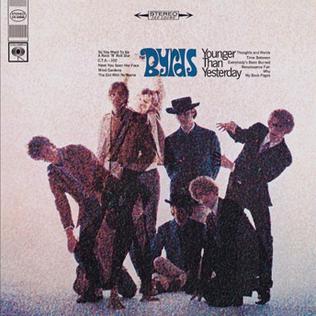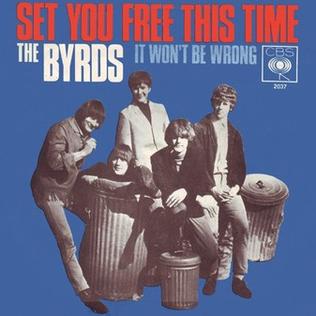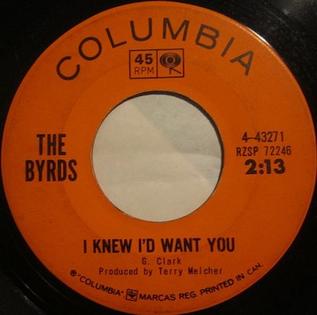Related Research Articles

The Byrds were an American rock band formed in Los Angeles, California, in 1964. The band underwent multiple lineup changes throughout its existence, with frontman Roger McGuinn remaining the sole consistent member. Although their time as one of the most popular groups in the world only lasted for a short period in the mid-1960s, the Byrds are today considered by critics to be among the most influential rock acts of their era. Their signature blend of clear harmony singing and McGuinn's jangly 12-string Rickenbacker guitar was "absorbed into the vocabulary of rock" and has continued to be influential.
"Mr. Tambourine Man" is a song written by Bob Dylan, released as the first track of the acoustic side of his March 1965 album Bringing It All Back Home. The song's popularity led to Dylan recording it live many times, and it has been included in multiple compilation albums. It has been translated into other languages and has been used or referenced in television shows, films, and books.

Harold Eugene Clark was an American singer-songwriter and founding member of the folk rock band the Byrds. He was the Byrds' principal songwriter between 1964 and early 1966, writing most of the band's best-known originals from this period, including "I'll Feel a Whole Lot Better", "She Don't Care About Time", "Eight Miles High" and "Set You Free This Time". Although he did not achieve commercial success as a solo artist, Clark was in the vanguard of popular music during much of his career, prefiguring developments in such disparate subgenres as psychedelic rock, baroque pop, newgrass, country rock, and alternative country. He was inducted into the Rock and Roll Hall of Fame in 1991 as a member of the Byrds.

Younger Than Yesterday is the fourth studio album by the American rock band the Byrds and was released on February 6, 1967 on Columbia Records. It saw the band continuing to integrate elements of psychedelia and jazz into their music, a process they had begun on their previous album, Fifth Dimension. In addition, the album captured the band and record producer Gary Usher experimenting with new musical textures, including brass instruments, reverse tape effects and an electronic oscillator.

Mr. Tambourine Man is the debut studio album by the American rock band the Byrds and was released on June 21, 1965, by Columbia Records. The album is characterized by the Byrds' signature sound of Jim McGuinn's 12-string Rickenbacker guitar and the band's complex harmony singing. The material on the album mostly consists of cover versions of folk songs, primarily composed by Bob Dylan, and originals written or co-written by singer Gene Clark. Along with the Dylan-penned single of the same name, Mr. Tambourine Man established the band as an internationally successful act and is widely regarded by critics as representing the first effective American challenge to the chart dominance of the Beatles and other British Invasion bands during the mid-1960s.

Turn! Turn! Turn! is the second studio album by American rock band the Byrds, released on December 6, 1965, by Columbia Records. Like its predecessor, Mr. Tambourine Man, the album epitomized the folk rock genre and continued the band's successful mix of vocal harmony and jangly twelve-string Rickenbacker guitar. The album's lead single and title track, "Turn! Turn! Turn!", which was adapted by Pete Seeger from text in the Book of Ecclesiastes, had previously been arranged in a chamber-folk style by the Byrd's lead guitarist Jim McGuinn for folk singer Judy Collins' third album, but the arrangement he used for the Byrds' recording of the song utilizes the same folk-rock style as the band's previous hit singles.

Fifth Dimension is the third album by the American rock band the Byrds and was released in July 1966 on Columbia Records. Most of the album was recorded following the February 1966 departure of the band's principal songwriter Gene Clark. In an attempt to compensate for Clark's absence, guitarists Jim McGuinn and David Crosby increased their songwriting output. In spite of this, the loss of Clark resulted in an album with four cover versions and an instrumental, which critics have described as "wildly uneven" and "awkward and scattered". However, it was the first Byrds album not to include any songs written by Bob Dylan, whose material had previously been a mainstay of the band's repertoire.

The Byrds' Greatest Hits is the first greatest hits album by the American rock band the Byrds and was released in August 1967 on Columbia Records. It is the top-selling album in the Byrds' catalogue and reached number 6 on the Billboard Top LPs chart, but failed to chart in the UK.

The Byrds is a four-CD box set by the American rock band the Byrds. It features music that had previously been released between the mid-1960s and early 1970s, along with a number of previously unreleased tracks and some new recordings from 1990. The box set was issued on October 19, 1990, by Columbia/Legacy and reached number 151 on the Billboard albums chart.

"Set You Free This Time" is a song by the American folk rock group the Byrds, written by band member Gene Clark. It was first released in December 1965 on the group's Turn! Turn! Turn! album, and later issued as a single in January 1966.

"I'll Feel a Whole Lot Better" is a song by the Los Angeles folk rock band the Byrds, first released in June 1965 on the B-side of the band's second single, "All I Really Want to Do". Despite initially being released as a B-side, the song managed to chart in its own right in the U.S., just outside the Billboard Hot 100. It was also included on the Byrds' debut album, Mr. Tambourine Man.

Preflyte is a compilation album by the American folk rock band the Byrds and was released in July 1969 on Together Records. The album is a collection of demos recorded by the Byrds at World Pacific Studios in Los Angeles during late 1964, before the band had signed to Columbia Records and become famous. It includes early demo versions of the songs "Here Without You", "You Won't Have to Cry", "I Knew I'd Want You", and "Mr. Tambourine Man", all of which appeared in re-recorded form on the band's 1965 debut album.
"Full Circle Song" is a country rock-style song written by Gene Clark. For the lyrics, he used an allegorical wheel of fortune motif to comment on the unpredictable nature of fame and fortune. Recorded in Los Angeles in 1972, the song was originally released on Clark's Roadmaster, which was only issued in the Netherlands in January 1973.

Never Before is a compilation album by the American rock band the Byrds, consisting of previously unreleased outtakes, alternate versions, and rarities. It was initially released by Re-Flyte Records in December 1987 and was subsequently reissued on CD in 1989, with an additional seven bonus tracks.

In the Beginning is a compilation album by the American folk rock band the Byrds and was released in August 1988 by Rhino Records. It features demo recordings made during 1964, before the band became famous.

McGuinn, Clark & Hillman were an American rock group consisting of Roger McGuinn, Gene Clark, and Chris Hillman, who were all former members of the band the Byrds. The group formed in 1977 and was partly modeled after Crosby, Stills, Nash & Young and, to a lesser extent, the Eagles. They were reasonably successful commercially in the United States, with their debut album reaching number 39 on the Billboard Top LPs & Tapes chart and the single "Don't You Write Her Off" reaching number 33 on the Billboard Hot 100.

"She Don't Care About Time" is a song by American folk rock band the Byrds. It was released on a non-album single in October 1965, as the B-side to "Turn! Turn! Turn!". The song was written by Gene Clark, the Byrds' main songwriter between 1964 and early 1966. "She Don't Care About Time" was recorded during sessions for the group's second album Turn! Turn! Turn!. The song is on most of the band's hits compilations.

"I Knew I'd Want You" is a song by the folk rock band the Byrds, written by band member Gene Clark, and first released as the B-side to their 1965 debut single, "Mr. Tambourine Man". It was also later included on their debut album, Mr. Tambourine Man.
"If You're Gone" is a song written by Gene Clark that was first released on the Byrds' 1965 album Turn! Turn! Turn!.
"The World Turns All Around Her" is a song written by Gene Clark that was first recorded by the Byrds for their second album Turn! Turn! Turn! (1965).
References
- 1 2 3 4 5 6 Rogan, J. (1997). The Byrds: Timeless Flight revisited. Rogan House. pp. 51, 84–85, 440–441, 481. ISBN 9780952954019.
- 1 2 3 Hjort, C. (2008). So You Want to Be a Rock 'n' Roll Star: The Byrds Day-by-Day 1965-1973. Jawbone. p. 31. ISBN 9781906002152.
- 1 2 3 4 5 Greenwald, M. "Here Without You". AllMusic . Retrieved 2014-02-24.
- 1 2 3 Perone, J.E. (2012). The Album: A Guide to Pop Music's Most Provocative, Influential and Important Creations. ABC-CLIO. p. 61. ISBN 9780313379079.
- 1 2 Levith, Will (18 August 2013). "Top 10 Gene Clark Songs". Ultimate Classic Rock. Retrieved 2017-02-12.
- ↑ Sheffield, R. (2004). Brackett, N.; Hoard, H. (eds.). The Rolling Stone Album Guide (4th ed.). Fireside. p. 126. ISBN 0743201698.
- ↑ Unterberger, R. "Mr. Tambourine Man". AllMusic . Retrieved 2014-02-24.
- ↑ Unterberger, R. "There Is a Season". AllMusic . Retrieved 2014-02-23.
- ↑ Deming, M. "Set You Free: Gene Clark in the Byrds 1964-1973". AllMusic . Retrieved 2014-02-24.
- ↑ Ankeny, J. "Time Between – A Tribute to The Byrds". AllMusic . Retrieved 2014-02-23.
- ↑ Deming, M. "More Guitar". AllMusic . Retrieved 2014-02-24.